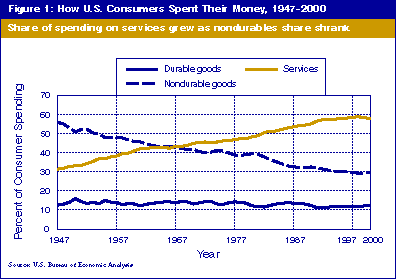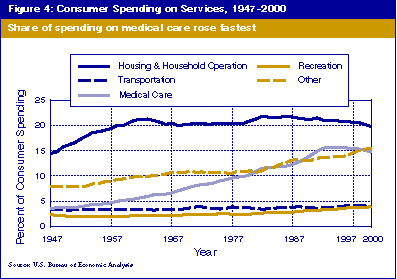Changing Spending Patterns
From month-to-month and year-to-year, consumer spending is a great constant in the economy. But seen over a longer period of time, changing prices and developing opportunities cause dramatic shifts in consumer spending.
In broad terms, there has been little change in the share of consumer spending claimed by durable goods in the period 1947 to 2000 (see Figure 1). Durables have fluctuated in a narrow range between 11% and 16% of personal consumption expenditures. By contrast, nondurable goods and services have exchanged positions in their share of consumer spending. Services were less than one-third of consumer spending in '47 and grew to 58% by 2000. This increase was possible because the components of nondurable goods fell in relative price, bringing this class of spending down from 56% to 30% of all consumer outlays.

Among durable goods (see Figure 2), motor vehicles and parts show a strong cyclical pattern since the late 1950s. But most of that movement lies between 5% and 7% of consumer spending. Furniture and household equipment gives evidence of a slight downward trend, but also exhibits some cyclicality. Rising in importance over the period were other durable goods, including computers, boats and the assets of affluence.

Nondurable goods (see Figure 3) saw a dramatic decline in the share of consumer spending going to food. Rising income and falling food prices drove the percent of total spending down from 32% to 14% of the consumers' outlays. Similarly, clothing expenditures have declined from nearly 12% to less than 5% of consumer spending, and energy has a declining claim on consumers' outlays.

Services include several sectors that grew dramatically over the past half-century (see Figure 4). Housing and household operations (including electricity and gas) assumed greater importance from the close of WWII until the early 1960s, but have remained stable since then at 20% of total consumer spending. Medical services rose steadily from 4% up to 15% in the early '90s, when they leveled off at 15%. Although transportation services have changed from trains and buses to airplanes, the portion of consumer spending going to this sector has remained fairly constant, below 5%. In similar fashion, Americans seem to be spending little more of their budgets on recreation today than they did 50 years ago.

The vast category of other services has nearly doubled as a portion of consumer spending. This group includes the barber, the beautician, the nail decorator, the veterinarian, the mini-storage facility, the CPA who works on taxes, and others who provide services for us, our pets or our possessions. It also includes the writing of computer software. Higher incomes make these services more accessible for more people.
There is a temptation to project these trends into the future. But how far will food fall as a portion of our spending when we choose more and more prepared food? Health care services may not rise as dramatically as in the past if we become more attuned to preventive measures. And if we are healthier, will we spend more on travel or on having our backs rubbed by a professional masseur?
